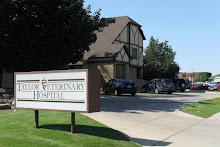Exercise is always good. It keeps the muscles
toned and helps to control weight by burning more calories. I want to point out
that in late in 2010 the American Medical community came out with a position
statement on exercise and weight control. The AMA said that you are more likely
to gain weight from what you eat rather than from lack of exercise. This does
not mean to stop exercising but it means we really need to control our food
intake.
Friday, May 11, 2012
Heart Disease in Pets
Dogs and cats, like people, may develop heart
disease as they get older, some are even born with some type of heart disease
and some are genetically prone to it. A good physical examination will make the
doctor aware of the problem but sometimes the owner will pick up signs before
they are visible in the examination room. The most common signs are that your
pet (cat or dog) is not running as well or for as long, is panting more, has
developed a cough, difficult breathing or has a bloated abdomen. A less well
known sign is a soft moist cough at about 3-4 am in the morning. This early
morning cough will seldom awaken you but if you are up for any reason, listen
for it.
When the veterinarian is concerned about the
possibility of heart disease there are a series of tests that we use to confirm
the diagnosis. The first is a good evaluation of the heart valves with a
stethoscope listening for murmurs or abnormal rhythm. We usually follow that up
with radiographs (X-rays) of the chest looking for changes in the heart’s
shape. An electrocardiogram (EKG) will tell us about the electrical system that
powers the heart. We use ultrasound to look for heart tumors. We also use a
blood test called NT-proBNP. The blood test looks for the enzyme NT-proBNP that
is produced by the heart when it is in heart failure. I spoke with the Iowa
State Cardiology Department and they use this test only when there is a
question of whether the dog or cat’s problem is respiratory in origin versus
heart in origin. This helps separate the two. Sometimes it is very difficult to
tell if a dog is in heart failure so this test helps on those occasions. After
our detailed work up of your pet’s heart, and we are still not quite sure of
the problem, we will ask for a second opinion at the Iowa State Veterinary
College.
There a number of things that you as an owner
can do to prevent heart disease in your pet. The most important thing that you
can do for your pet’s heart health is to have a veterinarian do a good,
complete examination of your pet each year. This allows the doctor to evaluate
your pet, look at its history, talk to you about feeding, treats, exercise,
symptoms of disease, and answer all your questions.
The next most important thing is to keep his/her
weight under control. This requires several things. The first is to measure the
amount of food that you feed. This keeps track of the major source of calories
for your pet and if the weight goes up, we can show you, to the teaspoon, how
much food to take out to lower the weight to the optimum level. Also remember
that for every pound of fat on a dog or cat, there are an additional 5 miles of
blood vessels for the heart to pump blood through.
The next item to look at is treats. I always
recommend feeding baby carrots to dogs as treats and nothing else. This raw
food is not digested in your dog’s intestine so there are no calories to cause
weight gain. I believe cats should not have treats due to excess calories. The
advertisements on TV make all of us feel guilty if we do not buy this treat or
that treat. The problem is that they all taste good but just make your pet
fatter. There is absolutely no benefit to feeding commercial treats. (Yes, I
know some that claim to keep the teeth clean but weight gain is a far greater
threat to your pet’s health.) The best “treat” that you can give your dog or
cat is your undivided attention 2-3 times per day.
I hope this gives you an over view how to try to
prevent heart disease and also how we diagnose heart disease. If you have any
questions, please call us at 277-1883.
Subscribe to:
Post Comments (Atom)


No comments:
Post a Comment